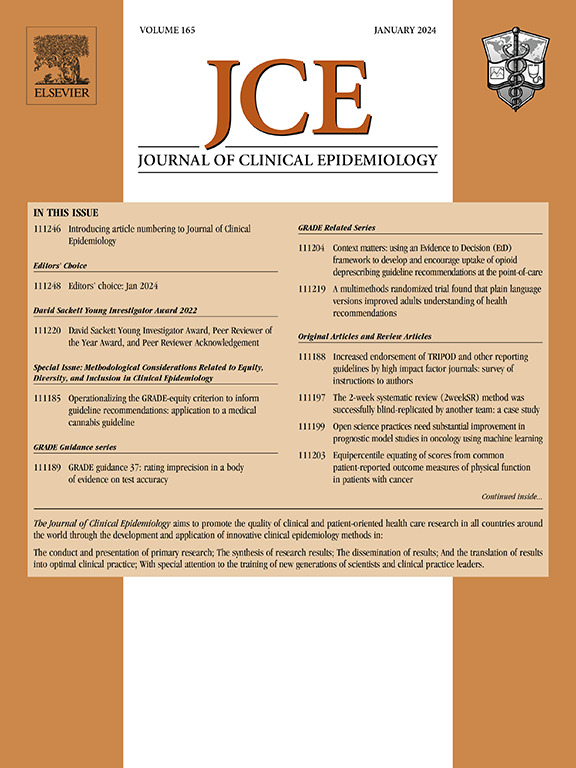一项方法审查确定了利用登记册进行随机对照试验的几种方案。
IF 7.3
2区 医学
Q1 HEALTH CARE SCIENCES & SERVICES
引用次数: 0
摘要
目的:以登记处为基础的随机对照试验(RRCTs)能以相对较低的工作量和成本在现实世界中提供内部有效的结果。然而,RRCT 的主要特点、注册表的利用程度(如来自注册表的数据比例)以及与注册表相关的局限性并不十分明确。本研究对RRCT进行了方法学回顾,旨在分析试验设计的特点,调查潜在的使用方案,并找出在RCT中使用登记数据可能存在的局限性:在PubMed上对截至2023/28/02正在进行的和已发表的RRCT进行了系统检索。纳入的研究报告中至少有一项结果来自登记处。研究筛选由两名审稿人独立完成。所有数据均被提取到标准表格中,并生成描述性统计:我们纳入了 162 项 RRCT(41 项方案和 121 项研究)。大多数 RRCT 为多中心试验(n=127;78.4%),包括大量参与者(中位数=1,787;范围=41-683,927)和较长的随访期(中位数=60 个月;范围=1-367 个月),随访损失极小。参与者的纳入标准大多定义宽泛。干预的类型从外科手术到行为干预不等,近一半的干预(46.9%)具有预防目的。主要登记结果大多是可客观测量的临床终点(40.1%)或主要临床事件的复合终点(30.9%)。我们发现登记册的使用程度各不相同,有的仅用于长期监测之前公布的数据,有的则更全面地用于招募患者、收集终点和长期随访。登记数据使用的局限性包括潜在的编码错误或数据不完整(如轻度病例记录不足)。此外,还必须考虑技术方面的挑战(如链接失败或数据录入延迟):登记册数据存在多种潜在的使用选择和使用范围。我们的分析表明,在许多情况下,使用登记册数据的潜力及其益处并未得到充分利用。此外,本研究还表明,设计 RRCT 并不存在单一、统一的方法,登记册可以通过各种方式为 RCT 提供支持。因此,未来的 RRCT 应明确说明登记册的用途和使用程度。此外,RRCT 的明确定义和分类对于促进未来有关 RRCT 的对话和研究似乎很有必要。本文章由计算机程序翻译,如有差异,请以英文原文为准。
A methodological review identified several options for utilizing registries for randomized controlled trials
Objectives
Registry-based randomized controlled trials (RRCTs) can provide internally valid results in a real-world context at relatively low effort and cost. However, the main characteristics, the extent to which the registry is utilized (eg, proportion of data from registry) and registry-related limitations are not well characterized. This methodological review of RRCTs aims to analyze the trial design features, investigate potential usage options, and identify possible limitations of using registry data for randomized controlled trials (RCTs).
Study Design and Setting
A systematic search in PubMed for ongoing and published RRCTs was conducted up to February 2, 2023. Studies that reported at least one outcome derived from a registry were included. Study selection was independently performed by two reviewers. All data were extracted into a standardized table, and descriptive statistics were generated.
Results
We included 162 RRCTs (41 protocols and 121 studies). Most RRCTs were multicenter trials (n = 127; 78.4%) comprising a large number of participants (median = 1787; range = 41 to 683,927) and a long follow-up period (median = 60 months; range = 1 to 367 months) with a minimal loss to follow-up. The inclusion criteria of participants were mostly broadly defined. Types of interventions ranged from surgical procedures to behavioral interventions, and almost half of the interventions (46.9%) had a preventive purpose. The main registry outcome was mostly a clinical endpoint (40.1%) or a composite endpoint of major clinical events (30.9%) that was objectively measurable. We found different degrees of registry utilization, ranging from the exclusive use of long-term monitoring of previously published data to the more comprehensive registry utilization for patient recruitment, endpoint collection, and long-term follow-up. Limitations related to the use of registry data comprised potential coding errors or incomplete data (eg, due to under-recording of mild cases). In addition, technical challenges must be considered (eg, failed linkages or time-delayed data entry).
Conclusion
A broad spectrum of potential usage options and usage extent of registry data exist. Our analysis suggests that in many cases, the potential of using registry data and thus their benefits were not fully utilized. In addition, the study illustrates that there is not a single, unified methodology for designing RRCTs but that registries can support RCTs in various ways. Therefore, future RRCTs should specify for what purposes and to what extent registries were utilized. Moreover, a clear definition and taxonomy of RRCTs appears necessary for facilitating future dialogue and research on RRCTs.
求助全文
通过发布文献求助,成功后即可免费获取论文全文。
去求助
来源期刊

Journal of Clinical Epidemiology
医学-公共卫生、环境卫生与职业卫生
CiteScore
12.00
自引率
6.90%
发文量
320
审稿时长
44 days
期刊介绍:
The Journal of Clinical Epidemiology strives to enhance the quality of clinical and patient-oriented healthcare research by advancing and applying innovative methods in conducting, presenting, synthesizing, disseminating, and translating research results into optimal clinical practice. Special emphasis is placed on training new generations of scientists and clinical practice leaders.
 求助内容:
求助内容: 应助结果提醒方式:
应助结果提醒方式:


